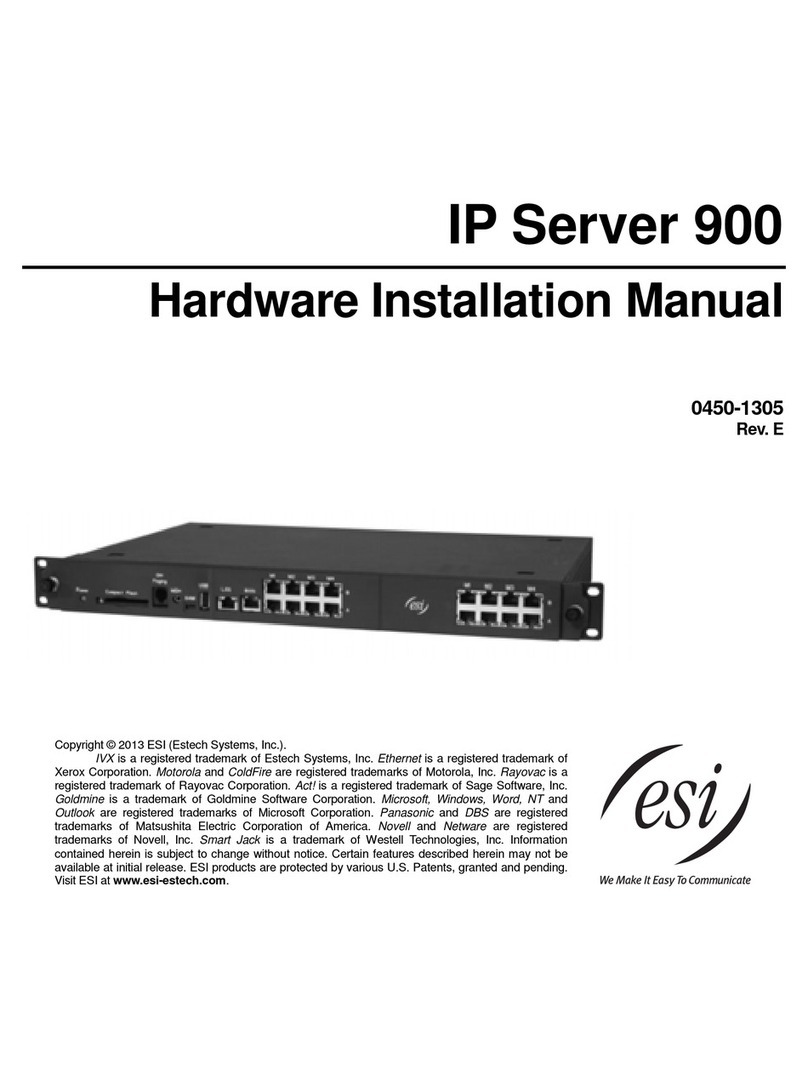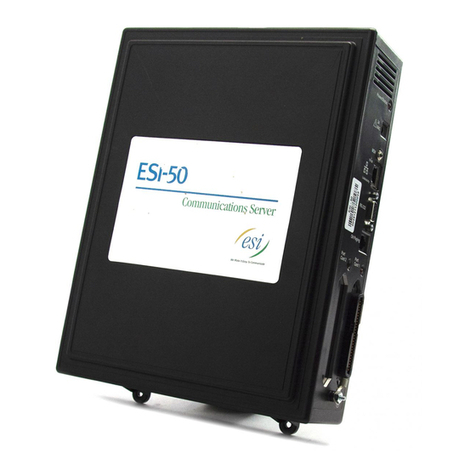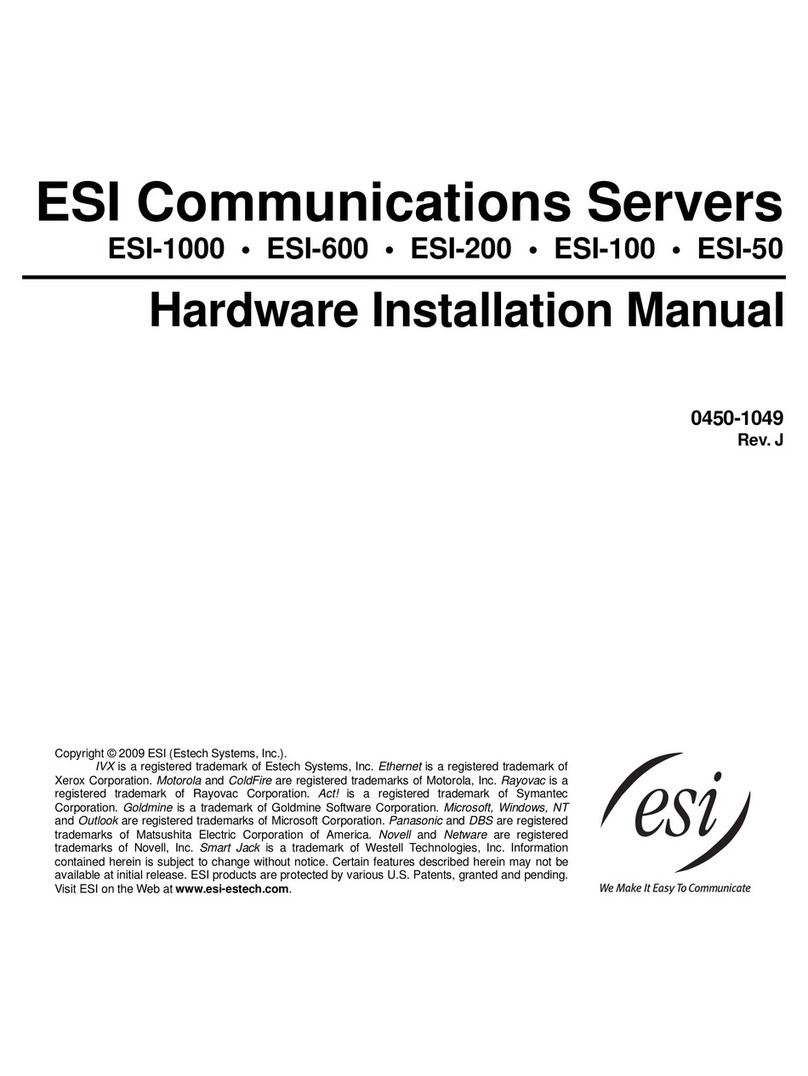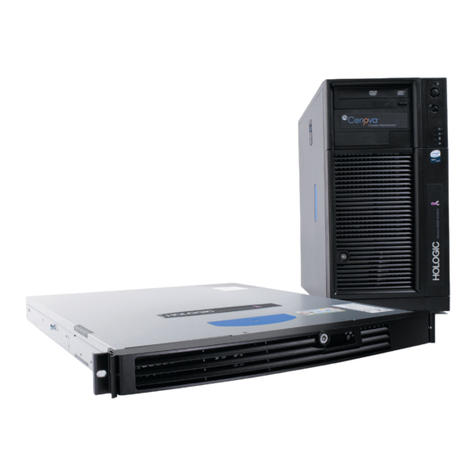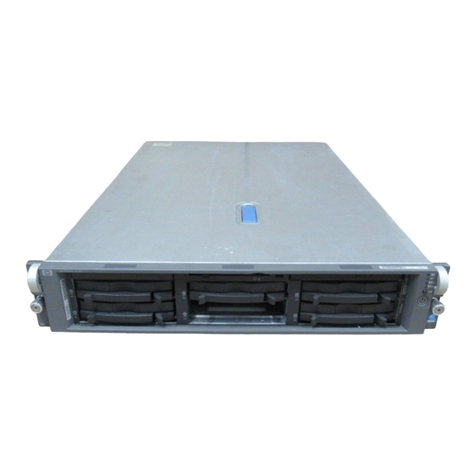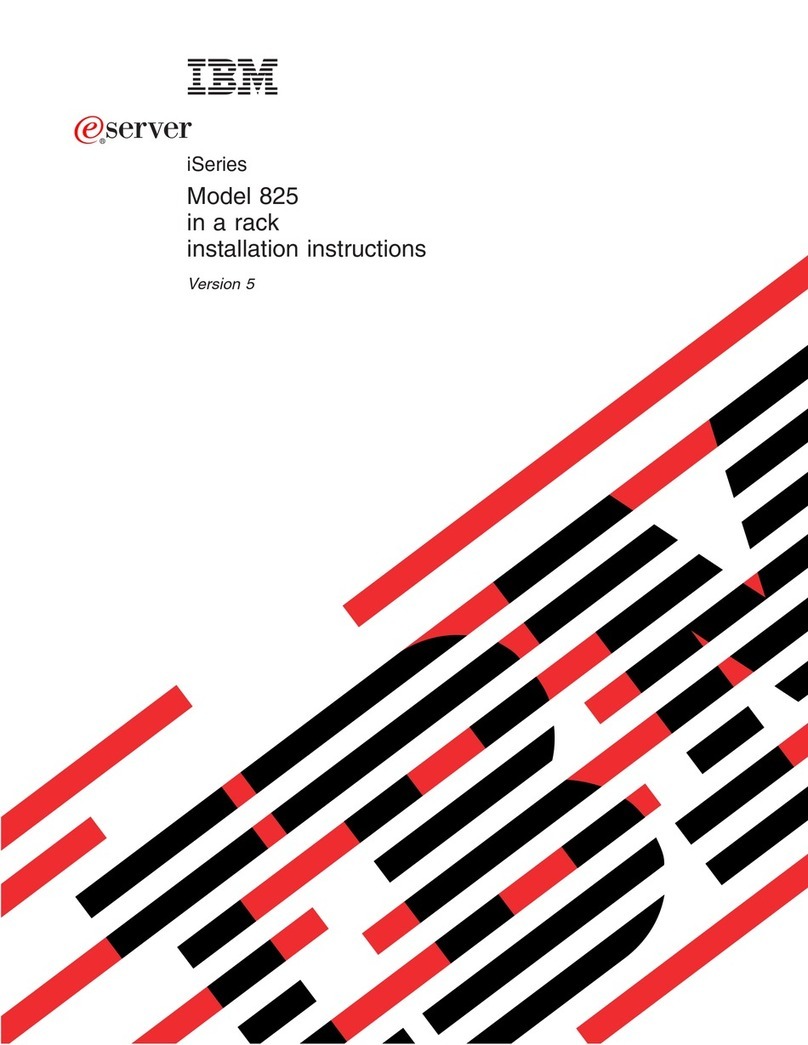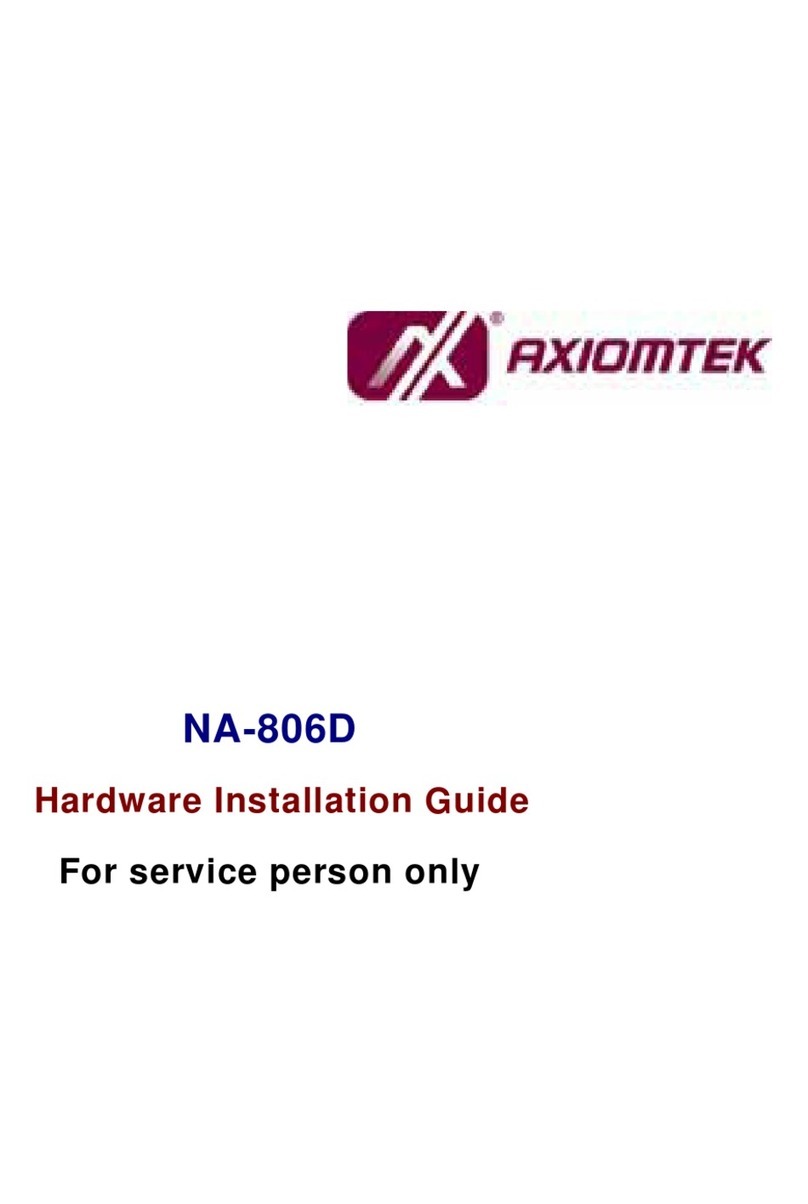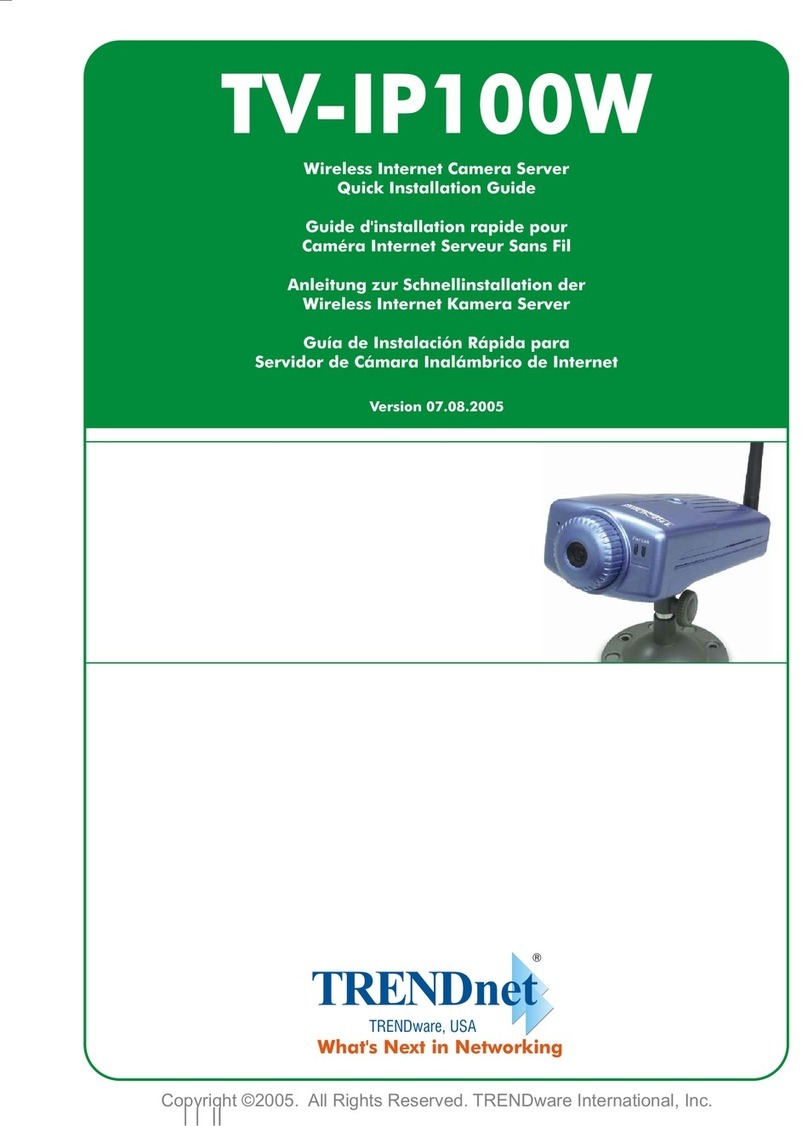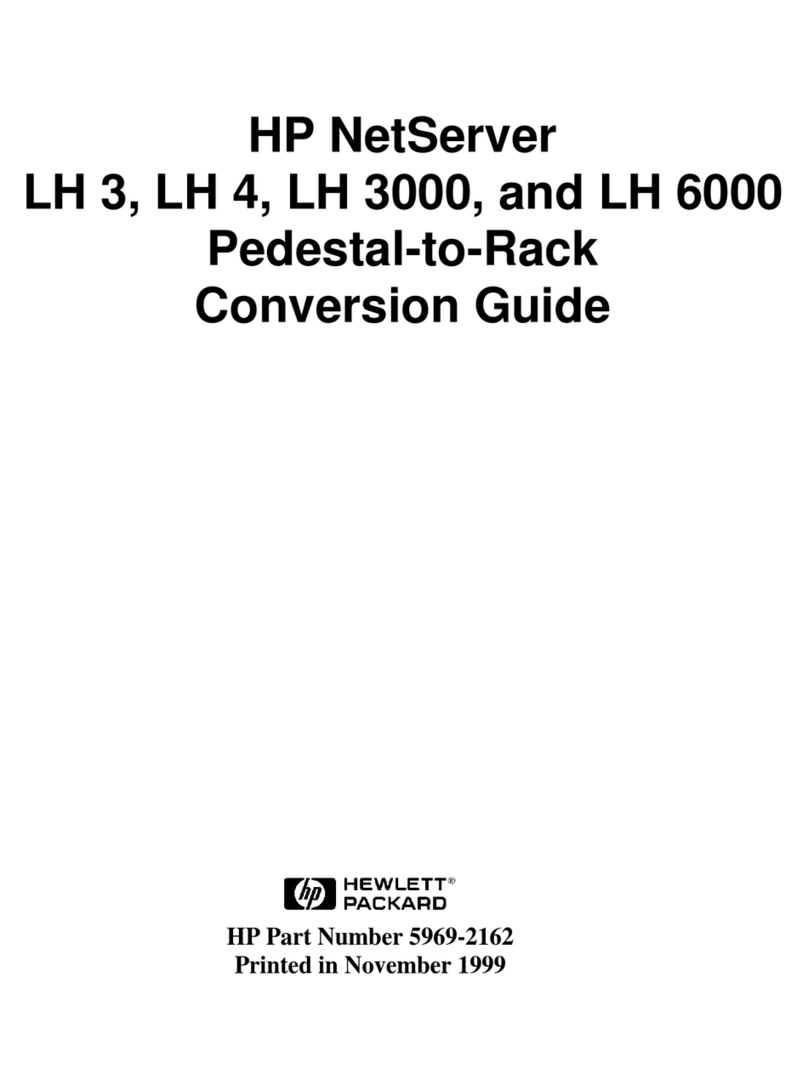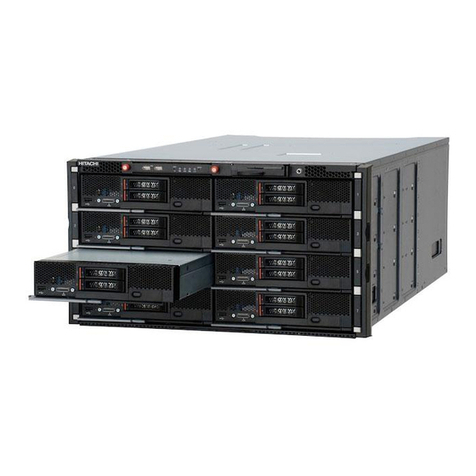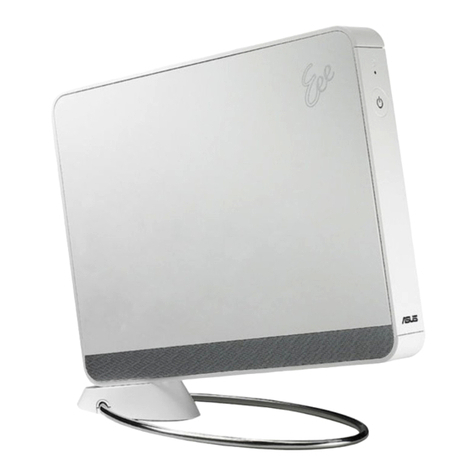ESI ESI Phone User manual

ESI Phone
User’s Guide
FOR THE ESI-50L Communications Server
Covering these current ESI phone models:
ESI 60 Business Phone • ESI 40 Business Phone
48-Key Feature Phone • 24-Key Feature Phone • ESI Cordless Handset II
. . . and these legacy ESI phone models:
12-Key Feature Phone • [Original] ESI Cordless Handset
0450-1135
Rev. F
For on-line help, visit www.esi-estech.com/users.
About ESI
ESI (Estech Systems, Inc.) is a privately held corporation based in Plano, Texas. Founded in 1987, ESIdesigns and
builds innovative telecommunications products forbusinesses like yours. Because of their powerful combination of
value and features, ESI products are consistently recognized by industry publications and leaders.
Copyright © 2011 ESI (Estech Systems, Inc.).
Esi-Dex, Quick Groups, Quick Moves, Virtual Mailbox Key, AutoPage, Quick Page and Verbal User Guide
are trademarks of ESI. Microsoft, Windows and Outlook are registered trademarks of Microsoft Corporation.
Information contained herein is subject to change without notice. ESI products are protected by various U.S. Patents,
granted and pending. Visit ESI on the Web atwww.esi-estech.com.

Contents
Introduction.............................................................................A.1
ESI 60 phone.........................................................................A.2
ESI 40 phone.........................................................................A.3
48-Key Feature Phone...........................................................A.4
Optional Expansion Consoles................................................A.5
24-Key Feature Phone...........................................................A.6
12-Key Feature Phone (legacy product).................................A.7
ESI Cordless Handset II.........................................................A.8
Connecting your ESI phone...................................................A.9
Help mode (Verbal User’s Guide)......................................B.1
User programming: An introduction................................C.1
User programming menu.......................................................C.1
Voice mail operation.............................................................D.1
VOICE MAIL key....................................................................D.1
Personal greetings.................................................................D.1
Leaving messages . . ............................................................D.2
AutoPage...............................................................................D.3
Moving and deleting a message............................................D.3
Off-premises “reach-me”........................................................D.3
Message retrieval...................................................................D.4
Live recording........................................................................D.8
Off-premises message delivery..............................................D.9
Message Recycle Bin(un-delete)........................................D.10
Status indicator lamp...........................................................D.10
Setting up twinning...............................................................D.11
Optionalvoice mail feature: Guest mailboxes......................D.12
Optional voice mail feature: Group/broadcast mailboxes.....D.14
Optionalvoice mail feature: Cascade notification mailboxes D.16
Optional voice mail feature: Q & A mailboxes......................D.18
ESI phone operation.............................................................E.1
Display...................................................................................E.1
Caller ID.................................................................................E.1
Keys.......................................................................................E.2
Dial tone.................................................................................E.4
Basic phone use....................................................................E.5
Direct station selection...........................................................E.6
Transferring an outside call. . ...............................................E.6
Transferring an internal call . . ............................................... E.8
Conference calling................................................................. E.9
Call forwarding.....................................................................E.10
Call waiting..........................................................................E.13
Hold/exclusive hold operation..............................................E.14
Paging.................................................................................E.16
Call pickup...........................................................................E.16
Optional features..................................................................E.17
Special keys............................................................................F.1
Esi-Dex .................................................................................. F.2
Override ring..........................................................................F.9
Message monitor mode (live call screening).........................F.10
Personal greeting reminder..................................................F.10
Headset operation................................................................F.10
Outside dialtone preference................................................F.13
Line keys..............................................................................F.13
Optional features..................................................................F.14
Analog stations .....................................................................G.1
Caller ID................................................................................ G.1
Placing calls.......................................................................... G.1
Transferring calls................................................................... G.2
Conference calling................................................................. G.2
Call waiting............................................................................ G.3
Call hold................................................................................ G.3
Paging................................................................................... G.3
Call pick-up ........................................................................... G.3
Voice mail operation from an analog station.......................... G.4
Analog station programming.................................................. G.6
Index

User’s Guide Introduction
A.1
Introduction
Accessing the rich ESI feature set is simple and easy through the straightforward design ofeach of the various
ESI phones. Each feature has been designed for ease of use while providing capabilities needed in an advanced
business phone.
You will be able to learn many of the features by simply using your phone; and this ESI-50L User’s Guide will
introduce you to the wide variety of features offered by your ESI system and how to use your phone effectively to
achieve maximum benefits.
What it covers
This User’s Guide covers the use of the following with yourESI system:
• ESI 60 phone (digital version)
• ESI 40 phone (digital version)
• 48-Key Digital Feature Phone
• 24-Key Digital Feature Phone
• 60-Key Expansion Console and Second Expansion Console
• ESI Cordless Handset II (digital version)
• [Legacy] 12-Key Digital Feature Phone
• Analog station
How it’s arranged
• Section A — Introduction and phone illustrations
• Section B — User help
• Section C — User programming
• Section D — Voice mail operation
• Section E — Phone operation
• Section F — Special keys and features
• Section G —Analog stations
Important: If you’re using a 48-Key Feature Phone, please note that this phone has separate PROGRAM and HELP
keys, rather than the combo PROG/HELP key found on the other models supported by your ESI system.
Therefore, you should press PROGRAM if programming your phone and the instructions tell you to press
PROG/HELP; or, similarly, you should press HELP if the instructions tell you to press PROG/HELP to obtain
assistance from the Verbal User Guide described herein (see page B.1).
Voice mail options
Your ESI-50Lsystem comes with ESI’s award-winning voice mail, including an automated attendant and a
dedicated mailbox foreach station.
The automated attendant provides up to 100 branches that conveniently route callers to their desired extensions
or departments, oreven destinationsoutside the system.
Some features are enabled by the Installer orSystemAdministrator. Consult your SystemAdministrator if you
are unsure about what features are available.

User’s Guide Introduction
A.2
ESI 60 phone
The ESI 60 phone has a variety of programmable and built-in features.The model that works with your system is
the ESI 60D (a digital phone). It supports up to two optional Expansion Consoles (see page A.5).TheESI60
models offers the same basic features which are described throughout this User’s Guide. The phone’s built-in voice
mail features and voice prompts make it easy to programand use.
Note: Depending on your angle of view, you will notice differences in the contrast levels of the upper and lower
displays. This is normal.
Items referenced elsewhere
Item Page
Item Page
PROG/HELP soft feature key C.2
Verbal User Guide and tutorial B.1
P/UP (pickup) key E.16
Status indicator lamp D.10
Fixed feature keys E.2
ESI-DEX soft feature key F.2
VOICE MAIL key D.1
RECORD key D.8
Programmable feature keys C.2
PAGE key E.16
Hint: On any of these ESI phone varieties (including the Expansion Consoles), you can perform direct
programming by holding down a programmable feature key for at least two seconds (similar to how you
might program a car radio button). This isn’t applicable to the fixed-feature keys which, as their name
implies, are already programmed.

User’s Guide Introduction
A.3
ESI 40 phone
The ESI 40 phone has a variety of programmable and built-in features. The model that works with your system is
the ESI 40D (a digital phone). Itsupports up to two optional Expansion Consoles (see page A.5).The ESI 40 offers the
same basic features which are described throughoutthis User’s Guide. The phone’s built-in voice mail features and
voice prompts make it easy to program and use.
Items referenced elsewhere
Item Page
Item Page
PROG/HELP soft feature key C.2
Verbal User Guide and tutorial B.1
P/UP (pickup) key E.16
Status indicator lamp D.10
Fixed feature keys E.2
ESI-DEX soft feature key F.2
VOICE MAIL key D.1
RECORD key D.8
Programmable feature keys C.2
PAGE key E.16
Hint: On any of these ESI phone varieties (including the Expansion Consoles), you can perform direct
programming by holding down a programmable feature key for at least two seconds (similar to how you
might program a car radio button). This isn’t applicable to the fixed-feature keys which, as their name
implies, are already programmed.

User’s Guide Introduction
A.4
48-Key Feature Phone
The legacy 48-Key Feature Phone has a variety of programmable and built-in features. Your system can use only
the digital version.This phone supports up to two optional Expansion Consoles(see page A.5).The 48-Key Feature
Phone offers the same basic features which are described throughoutthis User’s Guide. The phone’s built-in voice mail
features and voice prompts make iteasy to programand use.
Items referenced elsewhere
Item Page
Item Page
PROGRAM soft feature key C.2
HELP key for Verbal User Guide and tutorial B.1
P/UP (pickup) key E.16
Status indicator lamp D.10
Fixed feature keys E.2
ESI-DEX soft feature key F.2
VOICE MAIL key D.1
RECORD key D.8
Programmable feature keys C.2
PAGE key E.16
Hint: On any of these ESI phone varieties (including the Expansion Consoles), you can perform direct
programming by holding down a programmable feature key for at least two seconds (similar to how you
might program a car radio button). This isn’t applicable to the fixed-feature keys which, as their name
implies, are already programmed.

User’s Guide Introduction
A.5
Optional Expansion Consoles
Note: Your Installer or System Administrator must enable Expansion Console support for your extension before
you can use one or both Expansion Consoles.
The ESI 60, ESI 40, and 48-Key Feature Phone each can support up to two optionalExpansion Consoles, for
a possible total of 120 additionalprogrammable feature keys.
The 60-Key Expansion Console connects directly to the phone, while the Second Expansion Console
connects to the first Console.
You program each Expansion Console’s keys just as you do the programmable feature keys on your ESI phone,
using either direct or traditional programming (see page C.2).
Note: Only one key can exist per extension, feature or operation. If you program a second key for the same
extension, feature or operation, this automatically erases the first key so programmed, thus making it
available for a new extension, feature or operation.
Hint: You may find it easier to write in the names on the overlay before you program the keys and attach the
overlay to the Console.
60 programmable
feature keys
(pg. C.2)
in two banks
of 30 each
Hint: On any of these ESI phone varieties (including the Expansion Consoles), you can perform direct
programming by holding down a programmable feature key for at least two seconds (similar to how you
might program a car radio button). This isn’t applicable to the fixed-feature keys which, as their name
implies, are already programmed.

User’s Guide Introduction
A.6
24-Key Feature Phone
The 24-Key Feature Phone has features similar to those of the ESI desktop phones mentioned earlier.
However, the 24-Key Feature Phone doesn’t support IP, ESI’s VIP family of software applications1, or the
Expansion Consoles. As is true for the ESI phones mentioned earlier, the 24-Key Feature Phone has built-in voice
mail features and voice prompts that make it easy to program and use.
Items referenced elsewhere
Item Page
Item Page
PROG/HELP soft feature key C.2
Verbal User Guide and tutorial B.1
P/UP (pickup) key E.16
Status indicator lamp D.10
Fixed feature keys E.2
ESI-DEX soft feature key F.2
VOICE MAIL key D.1
RECORD key D.8
Programmable feature keys C.2
PAGE key E.16
Hint: On any of these ESI phone varieties (including the Expansion Consoles), you can perform direct
programming by holding down a programmable feature key for at least two seconds (similar to how you
might program a car radio button). This isn’t applicable to the fixed-feature keys which, as their name
implies, are already programmed.
1For information concerning these software applications, see the ESI Web site atwww.esi-estech.com.

User’s Guide Introduction
A.7
12-Key Feature Phone (legacy product)
The legacy 12-Key Feature Phone, still in use on many installed ESI systems, includes the basic, most
commonly used phone features. This simplified model doesn’t support IP, ESI’s VIP family of software
applications1, the Expansion Consoles, speakerphone operation2, or Esi-Dex.
Items referenced elsewhere
Item Page
Item Page
PROG/HELP soft feature key C.2
HELP key for Verbal User Guide and tutorial B.1
P/UP (pickup) key E.16
Status indicator lamp D.10
Fixed feature keys E.2
PAGE key E.16
Programmable feature keys D.1
Note: The following features aren’t available on a 12-Key Feature Phone:
• Certain special keys and features (see “Special keys,” page F.1F.1).
• Esi-Dex.
• ACD operation.
Additionally: to use voice mail, conference calling and mute/DND on a 12-Key Feature Phone, you must
program these features into programmable feature keys (see “Programmable feature keys,” page C.3, and
“Optional features,” page F.14).
Hint: On any of these ESI phone varieties (including the Expansion Consoles), you can perform direct
programming by holding down a programmable feature key for at least two seconds (similar to how you
might program a car radio button). This isn’t applicable to the fixed-feature keys which, as their name
implies, are already programmed.
1For information concerning these software applications, see the ESI Web site atwww.esi-estech.com.
2The 12-Key Feature Phone lacks a hands-free microphone, and thereforecan’t serve as a true two-way speakerphone. Its speaker plays pages.

User’s Guide Introduction
A.8
ESI Cordless Handset II
ESI’s Digital Cordless Handset II gives you most of the same features found in the 24-Key Feature Phone,but in
a compact, portable form. Note that it does not have the following features found on some ESIdesktop phones:
Esi-Dex support (or ESI-DEX key), Caller ID key, Virtual Mailbox Key support, or Verbal User Guide.
Each ESI Cordless HandsetII comes with a charger/AC adapter, base station, belt clip, battery pack,and wall mount.
Depending on your installation, your location may have one ormore optionalESI Cordless Handset Repeaters
so you can more easily stay in communication with your ESI system while you travel throughout the facility. If
you are unsure about whether your location has this capability, contact your SystemAdministrator.
Items referenced elsewhere
Item Page
Programmable feature keys C.2
VOICE MAIL key D.1
Fixed feature keys E.2

User’s Guide Introduction
A.9
Connecting your ESI phone
Depending on which ESI phone you have,use the appropriate diagram (below) to connect it. Each diagram
represents the panel on the phone’s underside.
Notes: The “Top of phone” and “Bottom of phone” references in these diagrams show the correct vertical
orientation of the phone — i.e., the part with the display is the top.
When the phone is in the highest upright position, use the wall-mount hook located under the handset to
secure the handset when you’re not using the phone.
24-Key Feature Phone
12-Key Feature Phone(legacy product)
• Connects like a basic phone.
• Handset plugs into right-side jack.
• Line cord plugs into left-side jack.
ESI 60 (digital version)
ESI 40 (digital version)
In addition to how the 24-Key Feature Phone connects to
the handset and line cord, note that each phone in this
group accepts a 60-Key Expansion Console cable
(included with each Console) which uses standard RJ-11
telephone connectors.
48-Key Digital Feature Phone
In addition to how the 24-Key Feature Phone connects
to the handsetand line cord, note that this phone
accepts a 60-Key Expansion Console cable (included
with each Console) which uses standard RJ-11
telephone connectors.

User’s Guide Introduction
A.10
60-Key Expansion Console connection
Notes: Your Installer or System Administrator must enable Expansion Console support for your extension before
you can use one or both Expansion Consoles.
The 60-Key Expansion Console can be connected to an ESI 60, ESI 40, or 48-Key Feature Phone.
If connecting both a 60-Key Expansion Console and a Second Expansion Console to a 48-Key Feature
Phone, see “Second Expansion Console connection,” page A.11.
1. Unplug the line cord from your ESI phone.
2. The 60-Key Expansion Console (right) includes a six-conductor
expansion cable. Connect one end of the expansion cable to the
appropriate connectoron the bottom of the ESI phone (below).
Then,connect the other end of the expansion cable to the 60-Key
Expansion Console.
3. To keep cabling out of the way, thread the expansion cable into the
slots on the bottom of the phone and 60-Key Expansion Console.
4. Program the keys on the 60-Key Expansion Console using the same
procedure as with the phone (pressPROG/HELP 2).
5. If necessary, remove the clearplastic overlay from the keys on the
Expansion Console.
6. For maximum convenience, label the paper overlay to show how
the keys are programmed (your Installer or SystemAdministrator can do this with ESI software).
7. Install the labeled paper overlay on the 60-Key Expansion Console.
8. Install the clear plastic overlay over the paper overlay, to protectit.
9. Use the provided Velcro®tape to attach the left side of the 60-Key Expansion Console to the right side of
the ESI phone.
10. Plug the line cord back into yourphone.
Connectors on bottom of phone

User’s Guide Introduction
A.11
Second Expansion Console connection
Notes: Your Installer or System Administrator must enable Expansion Console support for your extension before
you can use one or both Expansion Consoles.
The Second Expansion Console can be connected to a 60-Key Expansion Console that is connected to an
ESI 60, ESI 40, or 48-Key Feature Phone. If connecting only one Expansion Console to one of these phone
models, see “60-Key Expansion Console connection,” page A.10; the Second Expansion Console connects
to the 60-Key Expansion Console and cannot connect directly to the ESI phone.
1. Unplug the line cord from your ESI phone.
2. The Second Expansion Console1includes an expansion
“Y” cable (right)2. Lay out the cable across the back of
the equipment so that theAC adapter is on left and the
end of the cable is on the right.
3. Connect the right end of the expansion “Y” cable to the
appropriate connectoron the bottom of yourESI phone
(below).
4. Then, connect the expansion “Y” cable’s middle plug to the 60-Key Expansion Console, the left plug to
the Second Expansion Console,and theAC adapter to an appropriate 110 VAC outlet to provide power to
the Second Expansion Console (above).
5. To keep cabling out of the way, thread the expansion “Y” cable into the slots on the bottom of the phone
and the two Expansion Consoles.
6. Program the keys on the two Expansion Consolesusing the same procedure as with the phone (press
PROG/HELP 2).
7. If necessary, remove the clear plastic overlay from the keys on the two60-Key Expansion Consoles.
8. For maximum convenience, label the paper overlay to show how the keys are programmed (your Installer
or System Administrator can do this with ESI software).
9. Install the labeled paper overlays on the two 60-Key Expansion Consoles.
10. Install the clear plastic overlays over the paper overlays, to protect them.
11. Use the provided Velcro®tape to attach the left side of the 60-Key Expansion Console to the right side of the
phone, and the right side of the 60-Key Expansion Console to the left side of the Second Expansion Console).
12. Plug the line cord back into your ESI phone.
Connectors on bottom of Console-compatible ESI digital phone
1It’s physically identical to a 60-Key Expansion Console; consult your Installer if you have trouble determining which one it is.
2This diagramshows the backs of the Expansion Consoles.

User’s Guide Introduction
A.12
ESI Cordless Handset II connection
Each ESI Cordless Handset II comes with:
• A charger/cradle to charge the Handset.
• An AC adapter for use with only the charger.
• A base station to provide a digital interface between the ESI system and ESI Cordless Handset II.
This base station is line-powered and thus needs no AC power.
• Wall-mount(s), a belt clip, and a Quick Reference Guide.
Base station installation
Due to each site’s unique characteristics, the range and distance information we’ll provide herein is
only approximate.
Characteristics that positively affect performance:
• The base station should be installed so it has a clear line-of-sight with the Cordless Handset II.
• The base station antenna should always be pointed in its uppermost verticalposition.
Characteristics that negatively affect performance:
• Large amounts of metal shelving (such as in manufacturing or warehouse areas).
• Close proximity to (within one mile of)a radio tower.
• Concrete walls that divide spaces where Cordless Handsets II are used (assuming the base stations are
in one location).
Don’t install the base station:
• Close to a wall with metal studs.
• On a metal wall.
• Next to a device that emits RFI or EMI1— e.g.,a television, radio, computer, computer printer,
fluorescent light fixture, or fax machine.
• In a ceiling that has foil-backed insulation.
• Behind doors that typically are closed, tinted windows, one-way glass,or otherareas that limit or
cut off transmission to the Cordless Handset II.
Base stations must be installed at least 10 feet apart.Don’t install more than six base stations in one area
(such as a network room). Choose a location at least30 feet away if more than six base stations are needed
in a building.
A Digital Cordless Handset II base station requires only a line cord to the ESI system;AC power isn’t needed
because the base station receives power from the system via the line cord.
Note: Your facility may be equipped with one or more optional Cordless Handset II Repeaters. For more
information about this, consult your SystemAdministrator or your Certified ESI Reseller.
1RFI is radio frequency interference. EMI is electromagnetic interference.

User’s Guide Help mode (Verbal User’s Guide)
B.1
Help mode (Verbal User’s Guide)
Your ESI system’s Help mode (also called the Verbal User’s Guide) — a carefully conceived combination of
spoken information, display readouts and even key illumination when appropriate — is a powerful tool to help
you learn how to use the system’s many features.
Notes: As explained on page A.1, your ESI phone has a combo PROG/HELP key unless it is a 48-Key Feature
Phone (which has separate PROGRAM and HELP keys). Under the circumstances described in this
section, the PROG/HELP key will invoke Help mode.
The ESI Cordless Handsets have no access to the Verbal User Guide (and, thus, no key to invoke it).
Tutorial
When your station is idle, press PROG/HELP, and then follow the spoken Help menu to:
• Learn how to use the phone • Hear a description of how any key is used
• Learn how to use voice mail features • Hear a complete tutorial on phone operation
Help during station programming
To hear a detailed description of a function you wish to program, press PROG/HELP while programming it.
Help during a call
Press PROG/HELP while on a call and this will place the call on hold, whereupon you can use Help mode to
hear a description of the function you wish to perform. When you exit Help mode, you will be reconnected to
the call.
While you are either in Help mode or programming your phone, your station will be temporarily placed in DND
(see “MUTE/DND,” page E.4). Anyone calling your station while you are in DND will be forwarded to your
mailbox (or other destination set by the Installer).
Exiting Help mode
To exit Help mode, simply hang up.
For on-line help, visit www.esi-estech.com/users.

User’s Guide User programming: An introduction
C.1
User programming: An introduction
Voice prompts will play menu and sub-menu options to access the desired feature. Youdon't have to waitfor the
entire prompt to be played. Therefore, once you’ve become familiar with the prompts (consult “User
programming menu” on the nextpage), you can quickly set any frequently used feature.
Programming help
During any of the programming steps, press PROG/HELP to hear a more detailed description of the feature
and related programming options.
Exiting programming mode
To exit programming mode, simply hang up.
User programming menu
Overview
1 Select personal greeting
1 Record
2 Delete
3 Hear
2 Programmable feature keys
(Station keys, line keys, speed-dialkeys, other feature keys)
3 Station options
1 Call waiting/background announce
2 Personal greeting reminder
4 Outside dial tone preference
5 Hands-free answer
6 Message monitor
7 Power-saving mode1
4 Station audibles
1 Station ring tone
2 Station ring volume
3 Message ring
5 Password
1 Enter
2 Delete
3 Play back
4 Security level
6 External message notification
1 Delivery options
2 Phone delivery
3 Pager notification
4 Urgent message
6 Twinning programming
1 Enable/disable
2 Select destination
7 Personal Call Routing2
1 Entry settings
2 Exit settings
3 Quiet time settings
9 Un-delete
Note: Selections 3, 5 and 6, as well as the background announce function under “Station options” (see page
E.13), are not available on a legacy 12-Key Feature Phone. In addition, selection 6 6 (twinning
programming) is not available on an ESI Cordless Handset.
1For use with only ESI Cordless Handsets.
2Available only if your system is using ESI Presence Management. If you’re not sure whether it is, consult your SystemAdministrator. For more
information about ESI Presence Management, visitwww.esi-estech.com/presence.

User’s Guide User programming: An introduction
C.2
1 Select personal greeting
Select the desired greeting — 1, 2 or 3. The system will play the current greeting, followed by prompts to re-
record, delete or hear again — or select the current greeting by pressing #.
1 Record personal greeting
Begin recording at the tone. Press 1to stop. The new personal greeting automatically replaces the
previous greeting.
2 Delete personal greeting
When prompted, press 2again to confirm deletion.
Warning: Your mailbox is disabled if no personal greeting exists. Never delete all of your existing personal
greetings before you record at least one new one.
3 Hear current personal greeting
2 Programmable feature keys
There are two methods for programming of your phone:
• Direct programming — Select the key you want to program, and hold it down for at least twoseconds.
This not only initiates programming but also lets you immediately program that specific key.
• Traditional programming — Press PROG/HELP. The Verbal User’s Guide will speak to you, walking
you through the fullmenu, during which you can choose the appropriate option.
Direct programming example:
You wish to set one of the keys to dial a co-worker, whose extension is 105. Hold down the key for at
least two seconds. This automatically puts you in feature key programming. Follow the prompts to enter
1 0 5. (This has allowed you to skip two steps — pressing PROG/HELP and selecting a menu option —
that you’d have had to perform if using traditional programming.)
How the programmable feature keys can be set
• Line keys — Programming a line number (1 through 16) into a programmable feature key makes ita
line key, which provides the appropriate lamp information and manual outside-line access.
• Station keys — If the digits entered constitute a three-digitnumber, the programmable feature key
will become a station key, providing the appropriate lamp information and easy access or transfer.
Three-digit numbers entered can be:
— User extensions — Cascade mailboxes
— Department numbers — System speed-dial numbers
— Guest/info mailboxes
Note: The ranges for each will depend upon your specific system installation. Contact your System
Administrator for more information.
(Continued)

User’s Guide User programming: An introduction
C.3
• Speed-dial keys — In addition to programming a programmable feature key with asystem speed-dial
number, you can create personal speed-dial keys for automatic dialing of frequently called outside
numbers. If you program 9(or 8or 71–76) plus a phone number, the programmable feature key
becomes a speed-dial key. When you program a speed-dial key, there's no need to insert a pause
after the 9(or 8or 71–76). The speed-dial number can be up to 24 characters long. Use the up scroll
key () to enter special characters in a dial string.
You enter names for extensions, departments, branch IDs, CO lines, and guest mailboxesby
pressing the dial pad key that corresponds to the character to be entered. The key’s possible entries
will change each time the key is pressed, and the display will show this. When the desired character
appears on the display, press #to confirm; the cursor will move to the next character position. You may
move the cursor left (to correct an entry) by pressing the left scroll key (
) or move right (to add a
space)by pressing the right scroll key (
).
Key Options Key Options
0 0, - (hyphen), _ (underline) 7 P, R, S, 7
1 Q, Z, 1, “_” (space) 8 T, U, V, 8
2 A, B, C, 2 9 W, X,Y, 9
3 D, E, F, 3
(left scroll key) Backs up and erases
4 G, H, I, 4
(right scroll key) Adds a space
5 J, K, L, 5 # [Enter]
6 M, N, O, 6 # # Ends the name
Example: To enter a B, press 2twice (the possible options to scroll through are A, B, C and 2). When Bis
displayed, press#to confirm; the cursor will move to the next character to be entered. To complete
the name, press # #.
• Other feature keys — If you enter a feature code, the programmable feature key will serve as an
enable/disable key for that feature.The Installer may have programmed certain stations for accessing
additional features (see “Optional features,” page F.14); consult your System Administrator to
determine your access.
Keys’ LED activity during programming
Key type and LED indication
Mode Station key or
Virtual Mailbox Key
Line key Feature key
or speed-dial key
Currently being programmed and
previously assigned Flashing red Flashing green Flashing amber
Currently being programmed and
previously unassigned Flashing red Flashing red Flashing red
Programming mode — Was assigned or viewed in
current session Blinking red Blinking green Blinking amber
Assigned in a previous programming session and
not yet viewed in current session Solid red Solid green Solid amber
Never assigned and not yet viewed in
current session Off Off Off
Note: Each ESI Cordless Handset has only one LED color — red — with similar blinking rates.

User’s Guide User programming: An introduction
C.4
3 Station options
The station options sub-menu (PROG/HELP 3) lets you activate or deactivate several features your station
can provide.At each option sub-menu, 1enables the option and 0disables it. (Each option listed below is
explained elsewhere in this manual, as noted.)
1 Call waiting/background announce
See page E.13 for call waiting and page E.13 for background announce.
Note: Background announce is not available on a legacy 12-Key Feature Phone.
2 Personal greeting reminder
See page F.10.
3 [Unused]
4 Outside dial tone preference
See page F.13.
5 Hands-free answer
Note: With an ESI Cordless Handset, use of this feature requires a headset.
See page E.3.
Note: Not available on a legacy 12-Key Feature Phone.
6 Message monitor
See page F.10.
Note: Not available on a legacy 12-Key Feature Phone.
7 Power-saving mode
Note: Applicable to only an ESI Cordless Handset.
Allows you to enable or disable an ESI Cordless Handset’s power-saving mode. Enabling this mode helps
achieve fullbattery life. However, if full-time status monitoring is required, you can disable this mode. In
power-saving mode, the system blocks all status updates1to the Cordless Handset when the Handset has
been idle for 30 seconds. Pressing the Cordless Handset’s keys or receiving an incoming call on it will
discontinue power-saving mode.
Note: When the handset has received no calls or status updates1for five minutes, the Cordless Handset
enters deep-sleep mode. During it, the display is blank and the LEDs don’t light up. If the system
sends any updates to the Cordless Handset, it will discontinue deep-sleep mode.
1For example: If you have a programmable feature keyset as a station key for someone’s extension, the system updates your Cordless Handset
based on that extension’s current status (busy, idle, do-not-disturb,or — with optional ESI Presence Management — off-premises).

User’s Guide User programming: An introduction
C.5
4 Station audibles
The station audibles programming provides control of the following audible items.
Note: Only the third setting, message ring, is applicable to the ESI Cordless Handset.
1 Station ring tone
You can select from six possible tones to help distinguish it from other nearby ringing phones.
Press
or to select a tone, then press #to accept it.
2 Station ring volume
Press
and to set the desired ringer volume (range: off to high), then press #to accept it.
Note: On an ESI desktop phone with a status indicator lamp, if the ringer volume is turned off, the status
indicator lamp will not “flutter” when an incoming or recalled call is presented to the phone (see
“Status indicator lamp,” page D.10).
3 Message ring
When enabled, this feature will periodically generate a short ring tone at your station as an additional alert
thatyou have new messages.
5 Password
1 Enter new password
Your password may consist of 2–8 digits followed by # (0 cannot be the first digit). Entering only 0 as the
password will turn off the password requirement.
2 Delete current password
Resets the password to the default password.
3 Hear current password
Displays and plays back the current password.
4 Password security level
Selection Result
0 No password required for access from any phone
1 Password required only for remote access, either off-premises or from other stations within the system
2 Password always required
Other manuals for ESI Phone
1
This manual suits for next models
8
Table of contents
Other ESI Server manuals
Popular Server manuals by other brands

Bang & Olufsen
Bang & Olufsen BeoMaster 5 manual
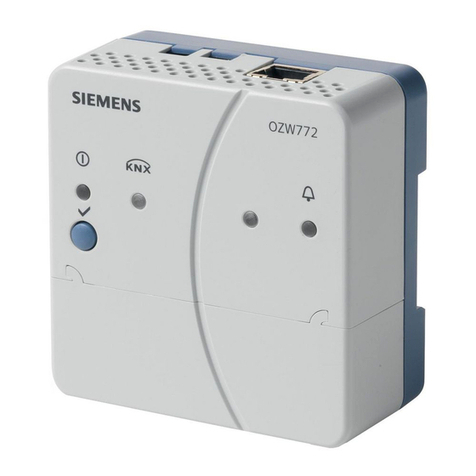
Siemens
Siemens OZW772 Series installation instructions
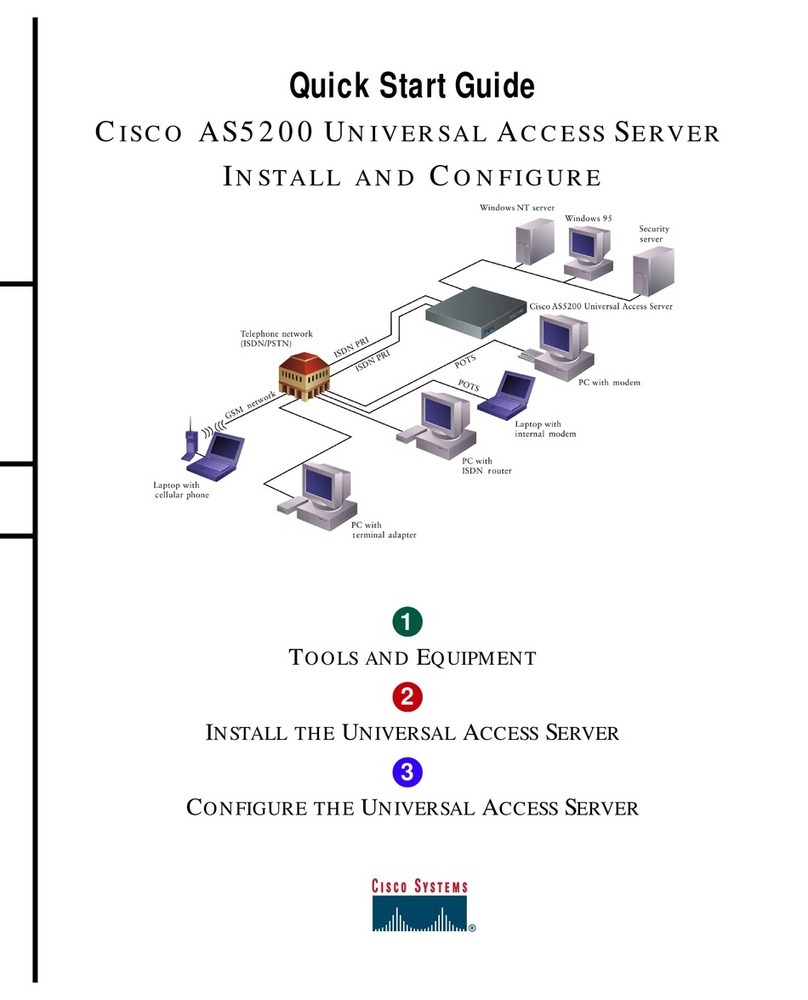
Cisco
Cisco AS5200 - Universal Access Server quick start guide

Netscape
Netscape NETSCAPE DIRECTORY SERVER 6.01 - PLUG-IN manual
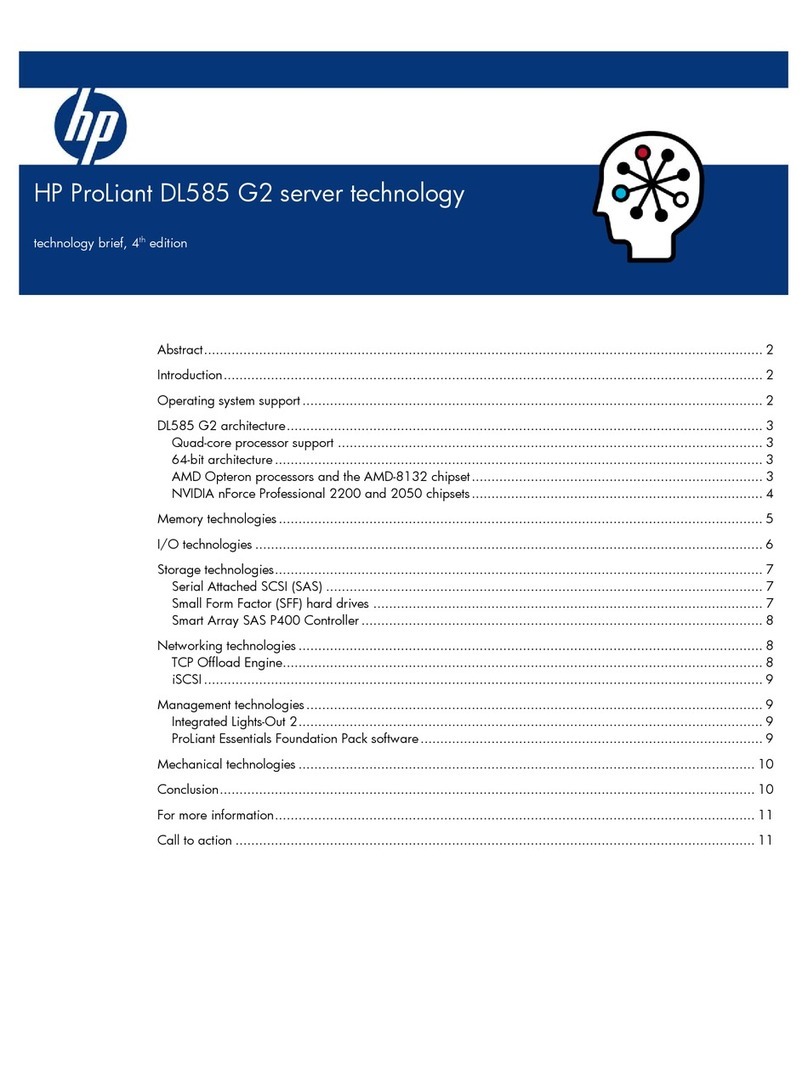
HP
HP ProLiant DL585 Technology brief

Supero
Supero SUPERSERVER 6016T-MR user manual



